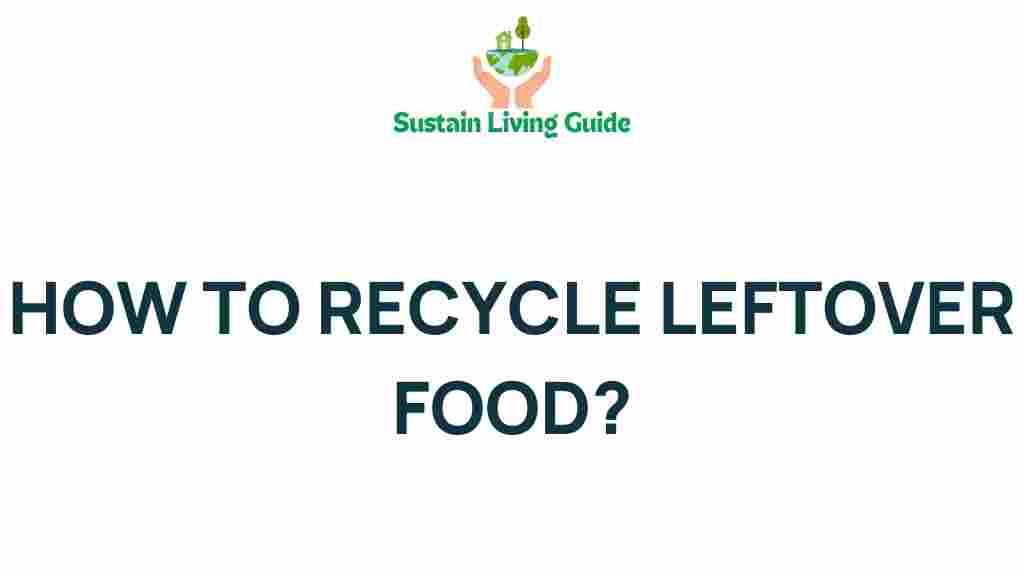Leftover Food: The Untapped Resource for Sustainability
In today’s fast-paced world, managing leftover food has become an essential aspect of sustainable living. With millions of tons of food wasted each year, understanding how to recycle and repurpose leftover food is crucial for both environmental and economic reasons. This article will uncover the secrets of leftover food recycling, providing you with practical tips, methods, and insights to utilize your leftover food effectively. Let’s dive in!
Understanding Leftover Food Recycling
Leftover food recycling entails the process of reusing or repurposing food that would otherwise go to waste. This can include various techniques such as composting, feeding animals, and creating new dishes from leftovers. Not only does this reduce waste, but it also conserves resources and minimizes the carbon footprint associated with food production. Here’s what you need to know about leftover food recycling:
- Environmental Impact: Reducing food waste significantly lowers greenhouse gas emissions.
- Cost Savings: Recycling leftover food can save money on groceries by maximizing what you already have.
- Community Benefits: Donating leftover food can help those in need, promoting social responsibility.
Step-by-Step Process for Recycling Leftover Food
Implementing a leftover food recycling strategy can be straightforward. Here’s a step-by-step guide to help you get started:
Step 1: Assess Your Leftovers
Begin by evaluating what leftovers you have. Check your fridge and pantry for items that are still safe to consume. This will help you understand what you can work with.
Step 2: Organize and Store Properly
Store leftovers in airtight containers to maintain freshness. Label each container with the date and contents to keep track of what needs to be consumed first.
Step 3: Plan Creative Recipes
Transform your leftovers into new meals. Here are some ideas:
- Soups and Stews: Combine various leftover vegetables and proteins for a hearty meal.
- Stir-Fries: Use leftover grains and proteins in a quick stir-fry with fresh vegetables.
- Casseroles: Mix different leftovers into a casserole for a comforting dish.
Step 4: Composting
If you have food scraps that are no longer suitable for consumption, consider composting. This process transforms organic waste into nutrient-rich soil. Here’s how:
- Collect: Gather vegetable peels, fruit scraps, and other compostable materials.
- Layer: Create layers of green (nitrogen-rich) and brown (carbon-rich) materials.
- Maintain: Turn the compost regularly and keep it moist for optimal decomposition.
Step 5: Donate Excess Food
If you have a surplus of food, consider donating it to local food banks or shelters. Many organizations accept leftover food in good condition, helping to feed those in need.
Troubleshooting Common Leftover Food Recycling Issues
Even with the best intentions, challenges can arise when recycling leftover food. Here are some common problems and their solutions:
Problem: Leftovers Spoiling Quickly
Solution: Ensure that leftovers are stored in airtight containers and kept at the appropriate temperature. Consume within 3-4 days to minimize spoilage.
Problem: Lack of Ideas for Repurposing Leftovers
Solution: Keep a recipe book or search online for leftover food recipes. Websites like FoodNetwork offer extensive ideas.
Problem: Composting Smells Bad
Solution: Ensure proper balance between green and brown materials. If odors persist, add more browns and turn the compost more frequently.
Benefits of Recycling Leftover Food
Adopting leftover food recycling practices can lead to numerous benefits:
- Environmental Sustainability: Reduces landfill waste and greenhouse gas emissions.
- Cost Efficiency: Saves money by making the most of your grocery purchases.
- Community Support: Provides resources to those who are food insecure.
Conclusion: The Future of Leftover Food Recycling
Recycling leftover food is not just a trend; it’s a necessary practice for a sustainable future. By taking simple steps to assess, organize, and creatively repurpose your leftovers, you can minimize waste and maximize resources. Whether through composting, cooking new meals, or donating excess food, every effort counts. Start implementing these strategies today and join the movement towards a greener planet.
For more detailed guides on food sustainability, check out this resource. Together, we can make a significant impact on our environment and communities by embracing the art of leftover food recycling.
This article is in the category Food and created by SustainLivingGuide Team

1 thought on “Uncovering the Secrets of Leftover Food Recycling”